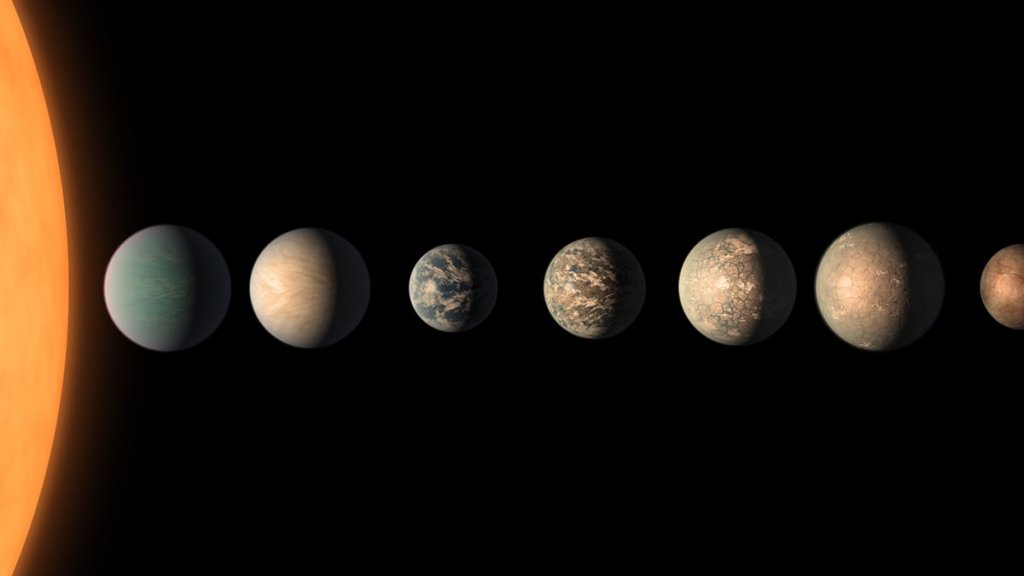Scientists have waited on pins and needles for more details about the TRAPPIST-1 solar system, a family of seven Earth-size planets discovered not too far away that could support life.
Now the James Webb Space Telescope, the mighty observatory in the sky run by NASA and the European and Canadian space agencies, is delivering some of that much-anticipated data. Astronomers just released the first results from an atmospheric study of one of the rocky exoplanets orbiting TRAPPIST-1, the host star just 41 light-years from Earth.
What they found so far may seem bleak: The innermost planet, TRAPPIST-1b, doesn’t appear to have an atmosphere and is a toasty 450 degrees Fahrenheit, according to a paper published Monday(Opens in a new tab) in the journal Nature. The measurements were determined by measuring the planet’s heat given off in the form of invisible infrared light.
But scientists say they’re just getting started, with much more research about this exoplanet and others in the TRAPPIST system(Opens in a new tab) to come. The biggest achievement, they say, is Webb’s successful detection of light from an exoplanet as small and cool as the rocky planets of our solar system — another first for the one-year-old telescope.
“There was one (telescope) target that I dreamed of having, and it was this one,” said co-author Pierre-Olivier Lagage in a statement(Opens in a new tab). “This is the first time we can detect the emission from a rocky, temperate planet. It’s a really important step in the story of discovering exoplanets.”
Tweet may have been deleted
(opens in a new tab)
(Opens in a new tab)
Taking an exoplanet’s temperature
To figure out the exoplanet’s temperature, the team measured the change in its “brightness” when it moved behind the star. The planet isn’t hot enough to give off its own visible light, but it does glow in the infrared, which is a wavelength of light we can’t see with the naked eye. By subtracting the brightness(Opens in a new tab) of the star from the brightness of the star and planet combined, they were able to calculate how much infrared light is being given off by the planet, NASA explained.
“This is the first time we can detect the emission from a rocky, temperate planet. It’s a really important step in the story of discovering exoplanets.”
Astronomers discovered the TRAPPIST-1 system about six years ago. Using the now-retired Spitzer Space Telescope(Opens in a new tab), they immediately identified it as an unusual family of tightly packed planets swarming a red dwarf, a tiny but violent type of star commonly found in the Milky Way. TRAPPIST-1 is just 10 percent the size of the sun.
Want more science and tech news delivered straight to your inbox? Sign up for Mashable’s Top Stories newsletter today.
TRAPPIST-1 system: What’s next?
Whether such stars can have planets with atmospheres able to support living things is a key question Webb is expected to help answer. Experts have speculated that one or two of the TRAPPIST worlds could be habitable.
“There are ten times as many of these stars in the Milky Way as there are stars like the Sun, and they are twice as likely to have rocky planets as stars like the Sun,” said Thomas Greene, lead author of the paper, in a statement. “But they are also very active — they are very bright when they’re young, and they give off flares and X-rays that can wipe out an atmosphere.”

Credit: NASA / JPL-Caltech / T. Pyle (IPAC)
If the initial results from TRAPPIST-1b come as a letdown, take heart: Scientists are much more interested in gauging the habitability of siblings D, E, and F. At first blush, they don’t appear to have the hydrogen-dominated atmospheres of gas giants(Opens in a new tab) such as Neptune, a planet not likely to support life.
In particular, TRAPPIST researchers are looking forward to studying E, the fourth planet(Opens in a new tab) from the star. It is thought to be the right distance to allow liquid water to form into lakes and oceans on the planet’s surface.
Knowing what’s in another planet’s atmosphere can tell scientists a lot about a world. The composition of Earth’s atmosphere changed when life arose on the planet. Suddenly, there was the presence of carbon dioxide and nitrogen.
Who knows what’s in the midst of the other TRAPPIST-1 worlds.

